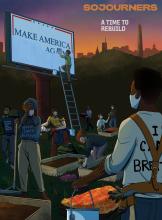AS A LATINA, I waited with eager anticipation for the publication of Robert Chao Romero’s Brown Church: Five Centuries of Latina/o Social Justice, Theology, and Identity . As a historian, Romero is the best person to take us through the history of the Latin American church, and he tells it truly, not wishing to shield the reader from the horrors of colonization. He begins with the exploitation and conversion “by the sword” that began under the rule of the Spanish conquistadores, who brought to the Americas their Roman Catholic faith—along with their hunger for gold and other resources. Early Catholic missionaries such as Friar Antonio de Montesinos and Bartolomé de las Casas sought to divorce the faith from the Spanish colonial project and condemned the latter with courage and fervor.
It is worthwhile to note that Romero brings his readers all the way to the present, introducing them to living Latinx theologians and their work. For many readers, his chapter on “Recent Social Justice Theologies of U.S. Latinas/os” will be a great resource for delving deeper into the works of living Latinx scholars and practical theologians. While the book heavily features male scholars and theologians, it was heartening to see this section highlight Mujerista theology and the work of Latinas doing theology—women such as Elizabeth Conde-Frazier, Sandra Maria Van Opstal, Noemi Vega Quiñones, and Zaida Maldonado Pérez.
Read the Full Article

